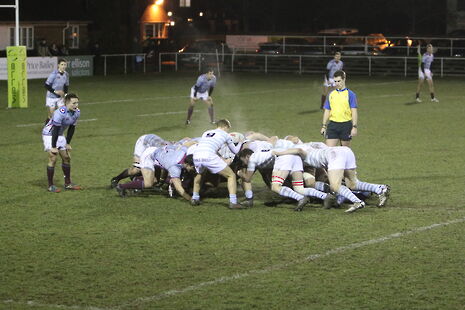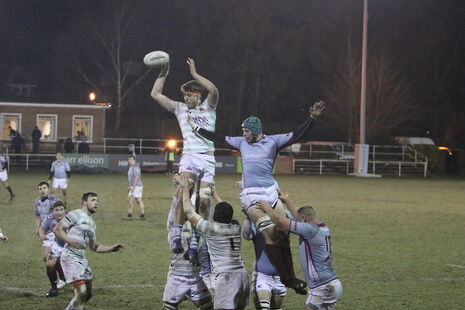RAF attack grounded by Blues in feisty draw
A tasty, scrappy affair was played out at Grange Road with honours even by the end of the evening

A drawn-out affair, lengthened by injuries and infringements alike, the Royal Air Force and their hosts, the Cambridge University RUFC Men’s Blues, could not be separated. The game lacked flow, and attacking opportunities were few and far between for both sides. Rather, much of the contest occurred between the 22s, with heavy collisions and set-pieces commonplace throughout.
The game began in the most exhilarating fashion. Hooker Andrew Burnett, one of seven Full Blues in the starting XV, charged down the opening clearance from the RAF. Winger Elliott Baines, a relatively new addition to the side, was beaten by smallest of margins to the ball by one of his adversaries for the night.
Cambridge controlled the ball for much of the opening frames; however, setting a trend that would hold for the rest of the match, were unable to fashion any attacking genuinely threatening opportunities.
Indeed, for all the Cambridge possession, it was the RAF who chalked up the first points on the scoreboard. As if dropped by Bomber Command, the high ball caused problems for the Cambridge back three all night, Dan Blick letting one slip through his fingers gifting the RAF an attacking scrum. From the set-piece, the RAF began a period of sustained pressure within the Light Blue 22. A driving maul from a lineout put the visitors only yards out, a position from which their forwards could bust the dam. The power of Cambridge, however, was not extinguished in one daring night-time raid.
Andrew Burnett was immense at hooker throughout what proved to be a short-lived appearance, succumbing to a monstrous collision just prior to half-time. His hard running in the middle of the park contributed to Cambridge’s carving of a foothold in the game before the break. Truly, all players on the park were immense, such was the level of intensity the game bore. Hennesey, playing at inside centre, was down for a lengthy period of time after a particularly big hit.
Both captains were regularly on the receiving end of dressing downs from referee Daniel Rowlands for their team’s play. Fisticuffs broke out shortly after Hennesey was felled, this time surrounding the breakdown of a scrum.
As the first half aged, Hennesey took the opportunity to pin the RAF deep in their own half. A succession of zealous scrums brought forth a penalty try from referee Rowlands.
Before the first half could come to a conclusion, however, one of the more bizarre happenings occurred. Cambridge lock Hunter was given the option by referee Rowlands of substituting himself or being shown a yellow card for entering the ruck at the side without the use of his arms; naturally he took the former.
Half time eventually came, with the scores level at 7-7.

Into the second half, the vociferous, incendiary protestations of the RAF bench continued unabated. The very spirit of rugby was challenged by the men of the Royal Air Force, on the touchline and the turf. Yet, the RAF were soon in the ascendancy, taking off promptly following the restart. A driving maul from a clean lineout sent the military men over the Cambridge whitewash for a 14-7 lead.
This was a game that lacked flow, piecemeal in its construction. For a significant portion of the second period the battle raged in the middle of the field, little attacking threat shown by either side.
It was rugger at its finest that finally broke the second period duck for the Light Blues. Hennesey collected the ball around the RAF ten-metre line. From there, showcasing his immense talent that has him on the books of Harlequins, he beat a handful of RAF men, leaving them grounded, before feeding Tyler Hammond for the score. An excellent kick from the centre levelled the contest.
The art of the set-piece is one that Cambridge have mastered over the year. For the full eighty minutes, the Light Blues were a cohesive unit upfront in the scrum. When under the shadow of their own posts, the RAF were compelled to error, not driving straight against a rigid Cambridge pack and surrendering one of a few gilt-edged opportunities to build an attack.
Hennesey was the man who finally gave the home side a lead. A loose ball presented itself to him around the half-way line and, from nothing, the centre on whom kicking duties were bestowed raced away from opponents to touch down under the posts before depositing the ball over those same posts.
However, the RAF were not to be beaten on this field, not this day. The conflict was not over after Hennesey’s score. Late RAF pressure in the corner resulted in forwards burrowing their way over the Cambridge line for the third try for the visitors of the night. An altogether scruffy conversion evened honours.
A frantic finish was the reward for those who persevered in the cold of the Fenlands until the bitter end. Such was the injury time that the RAF scrum-half was unaware of time and booted into touch inside his own 22, only to discover he had gifted the hosts an attacking opportunity. His blushes were spared, however, as the opportunity came to nothing, and referee Rowlands could bring to a close a mammoth contest.
Honours even was perhaps the most appropriate way to conclude a bruising affair in the harsh, wintry conditions. On a night when chances were few and far between, a draw is respectable for the Light Blues, having been trounced royally in their last outing against a military outfit.
Cambridge University RUFC: Blick, Hatteea, Russell, Hennesey, Baines, Perks, Bell; MacCallum, Burnett, Troughton, Hunter, Eriksen, Leonard, Hammond, Richardson.
Replacements: Huppatz, Schusman, Kolakowski, Kilpatrick, Elms, Triniman, Craib, Story.
RAF: Byrne, Robinson, Webber, Clarke, Tupua, Riddell, Parkin; Harris, Philpott, Kibble, Brougham, Hutchinson, Ellis, Bell, Johnson.
Replacements: Hales, Challenor, Morris, Cooper, Hadley, Breeze, MacDougll, Harper, Arnell
 News / Caius mourns its tree-mendous loss23 December 2025
News / Caius mourns its tree-mendous loss23 December 2025 News / Clare Hall spent over £500k opposing busway 24 December 2025
News / Clare Hall spent over £500k opposing busway 24 December 2025 Comment / The ‘class’ of Cambridge24 December 2025
Comment / The ‘class’ of Cambridge24 December 2025 Interviews / Politics, your own way: Tilly Middlehurst on speaking out21 December 2025
Interviews / Politics, your own way: Tilly Middlehurst on speaking out21 December 2025 Comment / Yes, I’m brown – but I have more important things to say22 December 2025
Comment / Yes, I’m brown – but I have more important things to say22 December 2025







